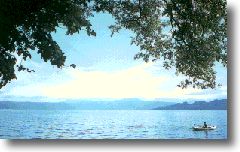|
| TRIP OUT TOP |
|
||
|
Access: Call JR Infoline in English at (03) 3423-0111 for various special 2-zone and other rail tickets for the Tohoku region. Tourist
Info: Aomori Tourist Information Center
(Aomori-shi Kanko-ka), Places
of Interest: Ski
Resorts: |
|
It’s freezing cold up in the northern part of the country, but if you make the trip you can take advantage of one of JR Higashi Nihon’s special tickets covering the Tohoku region. One destination is Aomori, which developed as a port town under Nobuhira, the second lord of the Tsugaru Clan, in 1624. Its name means the beautiful green (ao) of the pine forest (mori). Because it faces Hakodate across the Tsugaru Straits, it serves as the gateway to Hokkaido for both rail and sea traffic. The Aomori-Hakodate ferry service was inaugurated in 1873, but more or less went out of business when the Seikan (Aomori-Hakodate) ocean-floor tunnel was opened in 1988. This is the longest underwater tunnel in the world and its deepest point is 140 meters below sea level. The Hakkoda-maru ship, which now houses a memorial ship museum, was the most celebrated ship on the Seikan ferry route. Places of interest include the memorial museum built in the Azekura-style that is dedicated to famous son Munakata Shiko (1903-1975), a wood-block painter. The unusual 13-story triangular Aomori Prefectural Center for Industry and Tourism, the Aspam building, introduces the sights and industries of Aomori. Its observation lounge offers a panoramic view of Mutsu Bay and the Hakkoda Mountains. During the Aomori Winter Festival in mid-February, Gappo Koen Park features a big snow slide, a maze, snow house (kamakura) restaurants and buildings, animals and popular TV characters made of snow and ice. The 199 soldiers of the 5th Infantry Regiment who died in a blizzard in 1902 on Mt. Hakkoda are commemorated at the Setchu Kogun Sonan Memorial Museum. Since Aomori is famous for its August Nebuta Festival, which features huge lanterns with paintings of macho warriors and others, a visit to the Nebuta Museum, located a 40-minute bus ride away, is a must. During the evening, head northeast to Asamushi Spa, the leading spa resort in Tohoku for treating digestive-tract disorders and nervous illnesses. Its Asamushi Aquarium has more than 5,000 fish, and the swans that fly in from Siberia in mid-November and stay until March are designated a "Special National (International?!) Monument." It takes 30 minutes by local train from Aomori to Asamushi. Return to Aomori and head down south to the Sukayu Spa, which has acidic waters and a gigantic bath called the Senninburo. The idea is that 1,000 people (being a traditional bath the men and women are not separated) can bathe in it. At this time of year, it’s easy to ski in the Hakkoda Mountains, reached in one hour by bus from Aomori to Ropeway-mae Bus Stop. Mt. Odake (1,585m) and Mt. Kushigamine (1,517m) are among the dormant volcanoes which stand in the middle of Aomori Prefecture between Aomori and Lake Towada (Towada-ko). Towada-Hachimantai National Park is, as the name suggests, divided into two sections. The Hakkoda Mountains and Lake Towada, which form one part of the 854.1 sq. kilometer park, have the most exquisite landscapes. Oirasegawa River is the only river flowing out of Lake Towada, which is the third deepest lake in the country. There are many waterfalls here because of the lava rock pressing on both sides of the river, and the Hirosaki-Towada bus route runs right by the river. The Lake Towada symbol is a statue of two girls facing each other (“Otome no Zo”) by well-known sculptor and poet Takamura Kotaro (1883-1956). The statues stand among the trees along the bank not far from Lake Towada Bus Stop. Lake Towada Snow Festival with spectacular fireworks is held on the third weekend in February. You might want to return to Tokyo via Kuroishi, where the kokeshi dolls are made. Other interesting crafts in Aomori Prefecture are pigeon pipes (hatobue), clay dolls (tsuchi-ningyo), large wooden tops (zuguri), (distinctive figures of ancient warriors painted on kites (tako-e), snow dolls (yuki-ningyo) and apple-picking maiden dolls (ringo musume). |
|||

